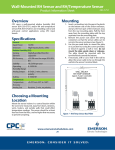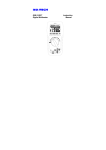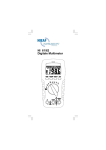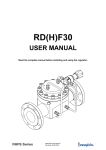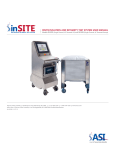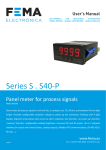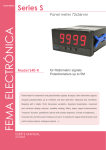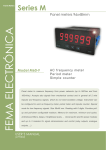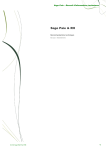Download LT-4203 Parallel Plate Test Cell Specifications
Transcript
Lambient TechnologiesTM LT-4203 Parallel Plate Test Fixture LT-4203 Parallel Plate Test Fixture Specifications and User’s Guide Figure 1 LT-4203 Parallel Plate Test Fixture DESCRIPTION The LT-4203 Parallel Plate Test Fixture is designed for measuring the AC loss characteristics and permittivity of solid laminates and panels per ASTM Standard D150-98, and implements the guarded electrode (three terminal) measurement preferred as the referee method. The standard sense electrode is 6.0 cm in diameter and the electrode separation may be adjusted to accommodate various sample thicknesses. A removable micrometer head permits measurement of electrode separation before testing. The 1.0 cm wide guard electrode eliminates fringing electric fields around the sense electrode for accurate calculation of test cell capacitance. Both electrodes are surrounded by a grounded frame which acts as a Faraday cage to reduce pickup of external electrical noise. Maximum operating temperature of the LT-4203 is 150 °C, allowing measurement of dielectric properties at elevated temperatures. Modification of the LT-4203 for operation up to 200 °C is available upon request. The LT-4203 Parallel Plate Test Fixture may be used with either the Lambient Technologies LT-451 Dielectric Cure Monitor or generic LCR meters. When used with the LT-4203, the LT-451 can test samples with thicknesses between 0.025 cm and 0.50 cm with optimum accuracy. Version 1.1 1 http://www.lambient.com Lambient TechnologiesTM LT-4203 Parallel Plate Test Fixture SPECIFICATIONS Dimensions: Overall (length x width x height) : 11.2 cm x 12.4 cm x 20.3 cm (4.4” x 4.9” x 8.0”) Diameter, excitation electrode : 8.00 cm Diameter, sense electrode : 6.00 cm (Area = 28.27 cm2) Width, guard electrode : 1.00 cm Composition: Electrodes Insulator Body : Stainless steel : Teflon : Aluminum Operational: Temperature, maximum : 150 °C (302 °F)* *Modification for operation to 200 °C (392 °F) available upon request Connections: Excitation electrode Sense electrode : BNC** : Triax** **Electrode connections may be modified upon request Recommended sample dimensions : 8.0 cm x 8.0 cm to 9.0 cm x 9.0 cm (maximum) Optimum sample thickness : 0.025 cm to 0.50 cm Test Fixture Parameters: A/D ratio Base (parasitic) capacitance : 28.27 cm2 / sample thickness in cm : ~15 pF (actual value may vary) Micrometer Attachment Accuracy Resolution : Removable for use at elevated temperatures : 0.03 mm (0.001”) : 0.01 mm (0.0005”) Features— On/Off switch Adjustable ZERO reference Absolute/Incremental readings Direct mm-in conversion Lambient Technologies L.L.C. 209 Newbury Street, 3rd Floor, Boston, MA 02116, USA (617) 266-2837 http://www.lambient.com [email protected] Version 1.1 2 http://www.lambient.com Lambient TechnologiesTM LT-4203 Parallel Plate Test Fixture PARTS LIST FOR THE LT-4203 PARALLEL PLATE TEST FIXTURE 1. Carefully remove the LT-4203 and its accessories from the shipping carton. 2. Check that all parts and accessories on the Packing List are included. Contents are subject to change without notice. The LT-4203 standard package has the following items: Qty Description 1 LT-4203 Parallel Plate Test Fixture 1 Removable micrometer (electronic indicator) 1 Transition box 1 BNC cable (black) 1 Triax cable (yellow) 1 LT-451 extension cable 1 3/32” Allen wrench 1 User’s Manual/Software manual on CD-ROM (English version)* 3. Check that all options on the Packing List are included. 4. Please report any missing items to your local Lambient Technologies representative immediately. *Contact local distributor for availability of documentation in other languages Version 1.1 3 http://www.lambient.com Lambient TechnologiesTM LT-4203 Parallel Plate Test Cell ASSEMBLING THE LT-4203 PARALLEL PLATE TEST FIXTURE Figure 2 below shows the LT-4203 Parallel Plate Test Fixture and knobs which adjust the plate separation and lock the plate position. Figure 2 LT-4203 Parallel Plate Test Fixture The digital indicator shown in Figure 3 is included for determining plate separation, but must be mounted by the user. Figure 3 Digital indicator Version 1.0 4 http://www.lambient.com Lambient TechnologiesTM LT-4203 Parallel Plate Test Cell Install the digital indicator as shown in Figures 4a and 4b. Figure 4a Figure 4b Figure 4a. Insert the probe tip of the digital indicator through the hole on the top plate of the LT-4203. The probe tip should touch the raised cylindrical piece just below the hole. Figure 4b. Use the included 3/32” Allen wrench to secure the indicator in place. Insert the Allen wrench through the hole on the left side of the top plate. NOTE: REMOVE THE INDICATOR BEFORE SUBJECTING THE TEST CELL TO ELEVATED TEMPERATURES. EXPOSURE TO HIGH TEMPERATURES WILL DAMAGE THE INDICATOR. The indicator may be removed by loosening the set screw and lifting the indicator from its mounting hole. CONNECTING THE LT-4203 TEST FIXTURE TO THE LT-451 DIELECTRIC CURE MONITOR The connections from the LT-4203 Test Fixture to the LT-451 Dielectric Cure Monitor are shown in Figure 5a, 5b, 5c and 5d. The LT-4203 has a BNC coaxial cable for the excitation signal and a triaxial cable for the response signal. These two cables connect to a transition box which routes the excitation and response signals into a single LT-451 extension cable. The LT-451 extension cable then plugs into the desired dielectric channel on the rear panel of the LT-451. Note that the LT-451 extension cable has a banana plug at both ends connected to the cable shield/conduit. These banana plugs connect the LT-451 chassis to the LT-4203 Test Fixture and are necessary to ground LT-4203 Faraday cage for proper operation and shielding. Version 1.0 5 http://www.lambient.com Lambient TechnologiesTM LT-4203 Parallel Plate Test Cell LT-451 Dielectric Cure Monitor LT-4203 Test Cell Shielded cables (BNC and triax) Transition box LT-451 extension cable Figure 5a Connections from the LT-4203 Test Fixture to the LT-451 instrument Figure 5b Cable connections from LT-4203 Test Fixture to transition box Figure 5c Ground connections from LT-451 extension cable to transition box The cable connections are as follows: a. Plug yellow triax cable into LT-4203 triax bulkhead connector (Figure 5b). b. Plug black BNC cable into LT-4203 BNC bulkhead connector (Figure 5b). c. Plug yellow triax cable into transition box bulkhead connector (Figure 5b). d. Plug black BNC cable into transition box bulkhead connector (Figure 5b). e. Plug LT-451 extension cable into transition box three-terminal connector (Figure 5c). Version 1.0 6 http://www.lambient.com Lambient TechnologiesTM LT-4203 Parallel Plate Test Cell f. Insert LT-451 extension cable ground plug into transition box jack (Figure 5c). g. Plug LT-451 extension cable into LT-451 three-terminal connector (Figure 5d). f. Insert LT-451 extension cable ground plug into LT-451 ground jack (Figure 5d). Figure 5d Ground connection from LT-451 extension cable to LT-451 chassis CONNECTING THE LT-4203 TEST FIXTURE TO A GENERIC LCR METER The connection from the LT-4203 Test Fixture to a generic LCR (InductanceCapacitance-Resistance) meter is shown in Figure 6. The LT-4203 has a BNC coaxial cable for the excitation signal and a triaxial cable for the response signal. The BNC cable must connect to the excitation output of the LCR meter. The triaxial cable must connect to the response input of the LCR meter. Typically the LCR meter input is a BNC and the user must provide a means of making the transition from a triax connector to a BNC connector. LCR meter LT-4203 Test Cell Shielded cables (BNC and triax) Figure 6 Typical connection from the LT-4203 Test Fixture to an LCR meter Version 1.0 7 http://www.lambient.com Lambient TechnologiesTM LT-4203 Parallel Plate Test Cell The guard electrode of the LT-4203 is connected to the internal (not outermost) shield of the triaxial cable as shown in Figure 7. Many LCR meters use a virtual ground input, and therefore simply ground the guard electrode of dielectric test cells through the shield of the response BNC connector. For an LCR meter with this configuration, the user must connect the internal shield of the LT-4203 triaxial cable to the response BNC ground. Upon request Lambient Technologies can modify the LT-4203 connectors or provide appropriate transition boxes for connection to specific LCR meters. LT-451 or LCR meter Excitation BNC coaxial cable Excitation electrode LT-4203 Test Cell Material Under Test Response Response Guard Triaxial cable Guard (BNC ground in many LCR meters) Figure 7 Typical excitation and response cabling to LT-4203 Test Fixture DETERMINING THE BASE CAPACITANCE (PARASITIC CABLE CAPACITANCE) OF THE LT-4203 The base capacitance CBASE , also known as the parasitic or cable capacitance, must be determined for accurate measurements of the capacitance between the electrodes. This base capacitance tends to be constant for a particular configuration of the LT-4203 Test Fixture, cabling and instrumentation, but it does depend on the length and type of cabling, and the input characteristics of the instrument. The base capacitance appears in parallel with the capacitance between the electrodes of the test cell, and its effect may be removed by simple subtraction from the raw measurement as shown below: CELECTRODE = CMEASUREMENT - CBASE The capacitance between the electrodes, CELECTRODE, represents the true capacitance of the measurement, whether with or without the Material Under Test, and is the basis for calculating dielectric properties. Version 1.0 8 http://www.lambient.com Lambient TechnologiesTM LT-4203 Parallel Plate Test Cell Following is the recommended procedure for determining the base capacitance: 1. Adjust the electrodes of the LT-4203 until they contact each other. 2. Zero the digital indicator by pressing the “ZERO” button. 3. Adjust the electrodes of the LT-4203 until the indicator reads 1.00 mm. 4. Measure the capacitance CMEAS 1 mm in air with electrode separation of 1.00 mm. 5. Adjust the electrodes of the LT-4203 until the indicator reads 5.00 mm. 6. Measure the capacitance CMEAS 5 mm in air with electrode separation of 5.00 mm. 7. Calculate ideal capacitance between electrodes. Electrode diameter is 6.00 cm, therefore the capacitance between the electrodes is: CELECTRODE = ε0 * A / D Where: ε0 = 8.86 x 10-14 F/cm A = π * (3.00 cm)2 = 28.27 cm2 D = separation between electrodes Therefore: CELECTRODE 1 mm = 25.05 pF (calculated for 1 mm separation) CELECTRODE 5 mm = 5.01 pF (calculated for 5 mm separation) 8. Calculate base capacitance at 1 mm and 5 mm: CBASE 1 mm = CMEAS 1 mm - CELECTRODE 1 mm CBASE 5 mm = CMEAS 5 mm - CELECTRODE 5 mm 9. Calculate average base capacitance: CBASE = ( CBASE 1 mm + CBASE 5 mm ) / 2 10. Example: CELECTRODE 1 mm = 25.05 pF (calculated air capacitance for D = 1 mm) CELECTRODE 5 mm = 5.01 pF (calculated air capacitance for D = 5 mm) Version 1.0 CMEAS 1 mm = 40.4 pF (measured air capacitance for D = 1 mm) CMEAS 5 mm = 20.1 pF (measured air capacitance for D = 5 mm) CBASE 1 mm = CMEAS 1 mm - CELECTRODE 1 mm = 15.35 pF CBASE 5 mm = CMEAS 5 mm - CELECTRODE 5 mm = 15.09 pF CBASE = ( CBASE 1 mm + CBASE 5 mm ) / 2 = 15.22 pF 9 http://www.lambient.com Lambient TechnologiesTM LT-4203 Parallel Plate Test Cell PARALLEL PLATE MEASUREMENTS Dielectric instrumentation measures electrical properties of the Material Under Test (MUT) between a pair of electrodes, which can be modeled as a conductance in parallel with a capacitance, as shown in Figure 8. Driven electrode IRES A D + GMUT CMUT VEXC Material Under Test (MUT) Grounded electrode Figure 8 Electrical model of dielectric Material Under Test The raw measurements at a given frequency f are: GMUT = conductance (ohms-1) CMUT = capacitance (farads) With the known quantities of: ω = 2πf ε0 = 8.86 x 10-14 F/cm A/D = ratio of area to distance for electrodes then it is possible to calculate the resistance: (eq. 1) RMUT = 1/GMUT (resistance) and the following material properties: (eq. 2) (eq. 3) (eq. 4) (eq. 5) Version 1.0 ρ = RMUT *A/D σ’ = GMUT / (εo * A/D) ε' = CMUT/ ( εo * A/D) ε" = σ’ / ω 10 (resistivity or ion viscosity) (relative conductivity) (relative permittivity) (loss factor) http://www.lambient.com Lambient TechnologiesTM LT-4203 Parallel Plate Test Cell Dissipation, or tanδ, at measurement frequency f is the ratio of a material’s relative loss to its relative permittivity, and is given by the relationship: tanδ δ = ε” / ε’ = 1 / (ω ω CMUT RMUT) (eq. 6) Dissipation can be measured in a test cell. In the case of a solid material which can be fabricated as a laminate or a panel, a parallel plate electrode configuration is often used. The guarded parallel plate electrodes of the LT-4203 are diagrammed below in Figure 9. LT-451 or LCR meter Excitation Excitation electrode Material Under Test (0.025 cm to 0.50 cm Thick TYP) Response Guard electrode Sense electrode (6 cm diameter, 28.27 cm2 area) Guard electrode Figure 9 Diagram of LT-4203 guarded parallel plate configuration For the configuration and electrode dimensions of Figure 9, the air capacitance of the test cell, and the capacitance when filled with a material of relative permittivity ε’ = 4.0 (typical for polyimide-glass composites) are listed below in Table 1: Version 1.0 11 http://www.lambient.com Lambient TechnologiesTM LT-4203 Parallel Plate Test Cell Table 1 Parameters of Example Parallel Plate Configuration Electrode Separation D (cm) 0.025 A/D Ratio (cm) 1130 Air Capacitance (εε’ = 1.0) Material Capacitance (εε’ = 4.0) 100 pF 400 pF 0.25 113.0 10.0 pF 40.0 pF The Lambient Technologies LT-451 uses the floating electrode method of dielectric measurement, which allows the determination of very high resistances with reduced noise at low frequencies (Ref. Lambient Technologies AN 3—Dielectric Measurement Techniques). Given the definition of tanδ (eq. 6), the maximum resistance which an instrument can measure, and the material capacitance, it is possible to calculate the smallest dissipation which the instrument can measure at a given frequency. Nominal performance limits of the Lambient Technologies LT-451 are shown in Table 2: Table 2 LT-451 Nominal Performance Limits Frequency Range 0.001 Hz to 100 Khz Optimal Capacitance Range ~20 pF to ~2000 pF Optimal Resistance Range ~1 KΩ Ω to ~100,000 MΩ Ω The results for the LT-451 are shown in Table 2 for a frequency of 60 Hz, commonly used because of interest in determining dielectric loss at AC mains frequency. The details for the calculations supporting these results are beyond the scope of this document, but may be obtained from Lambient Technologies upon request. Table 2 Comparison of Minimum Measurable tanδ δ at 60 Hz Material Capacitance LT-451 Max RP LT-451 Min tanδ δ 30 pF 1000 MΩ Ω 0.09 100 pF 300 MΩ Ω 0.09 300 pF 100 MΩ Ω 0.09 1000 pF 20 MΩ Ω 0.13 Version 1.0 12 http://www.lambient.com Lambient TechnologiesTM LT-4203 Parallel Plate Test Cell Note that to achieve a capacitance of 1000 pF for the LT-4203 Parallel Plate Test Fixture, the film must be 0.017 cm (< 0.007”) thick. While use of such thin films is possible and routine, air gaps can cause inaccuracies; in this case techniques which account for contributions due to air gaps should be used. CONTACTING ELECTRODE MEASUREMENTS The contacting electrode method requires only one measurement with the electrodes in direct contact with the MUT as shown in Figure 10. The surface of the MUT must be flat to prevent an air gap between the sample and the electrodes, which can cause a measurement error. The MUT should also be incompressible so the separation between the electrodes is the same as the true thickness of the sample. LT-451 or LCR meter Excitation Excitation electrode ta = thickness of Material Under Test (MUT) Response Guard electrode Response electrode (Area = A) Figure 10 Configuration for contacting electrode measurements Dielectric properties at frequency of measurement f are calculated below: (eq. 7) ε' (eq. 8) tanδ δ = ε” / ε’ = 1 / (ω ω CP RP) (eq. 9) ε" Where: ω = 2π * f ε0 = 8.86 x 10-14 F/cm CP = Capacitance of measurement RP = Resistance of measurement Version 1.0 = CP / ( εo * A / ta ) (relative permittivity) (dissipation) = ε' * tanδ δ 13 (loss factor) http://www.lambient.com Lambient TechnologiesTM LT-4203 Parallel Plate Test Cell NON-CONTACTING ELECTRODE MEASUREMENTS The non-contacting electrode method can obtain accurate results for dielectric properties in the presence of an air gap, but requires two measurements. One measurement determines the capacitance and dissipation of the test fixture at a known separation with only air between the electrodes, as shown in Figure 11a. The other measurement determines the capacitance and dissipation at the same separation with the sample inserted between the electrodes, as shown in Figure 11b. For this method the air gap and the compressibility of the MUT do not affect the results. LT-451 or LCR meter Excitation Excitation electrode tg = thickness of gap between electrodes Response Guard electrode Response electrode (Area = A) Figure 11a Non-contacting electrode measurement with air only between electrodes (First measurement) LT-451 or LCR meter Excitation Excitation electrode ta = average sample thickness (tg is unchanged) Response Guard electrode Response electrode Figure 11b Non-contacting electrode measurement with sample between electrodes (Second measurement) Version 1.0 14 http://www.lambient.com Lambient TechnologiesTM LT-4203 Parallel Plate Test Cell For low dissipation the dielectric properties at frequency of measurement, f, are calculated below: For (tanδ)2 << 1 (eq. 10) ε' = 1 / [ 1 – ( a * b ) ] (relative permittivity) (eq. 11) tanδ δ = tanδ δP2 + [ ε’ * c * d ] (dissipation) (eq. 12) ε" = ε' * tanδ δ (loss factor) Where: ω = 2π * f CP1 = Capacitance (F) without MUT inserted (Fig. 11a) RP1 = Resistance (Ω) without MUT inserted (Fig. 11a) tanδP1 = Dissipation without MUT inserted (Fig. 11a) = 1 / (ω CP1 RP1) CP2 = Capacitance (F) with MUT inserted (Fig. 11b) RP2 = Resistance (Ω) with MUT inserted (Fig. 11b) tanδP2 = Dissipation with MUT inserted (Fig. 11b) = 1 / (ω CP2 RP2) tg = Separation (m) between response and excitation electrodes ta = Average sample thickness (m) a = 1 - ( CP1 / CP2 ) b = tg / ta c = tanδP2 - tanδP1 d = ( tg / ta ) - 1 Results for the non-contacting electrode measurements can be as accurate as the measurements of electrode separation and sample thickness. But for situations where the air gap is a large fraction of the sample thickness, the calculations for relative permittivity, ε’, and dissipation, tanδ, are very sensitive to uncertainties in tg and ta . Consequently, non-contacting electrode measurements are best used for thicker samples where the air gap can be relatively small. Lambient Technologies L.L.C. 209 Newbury Street, 3rd Floor, Boston, MA 02116, USA (617) 266-2837 http://www.lambient.com [email protected] Version 1.0 15 http://www.lambient.com

















